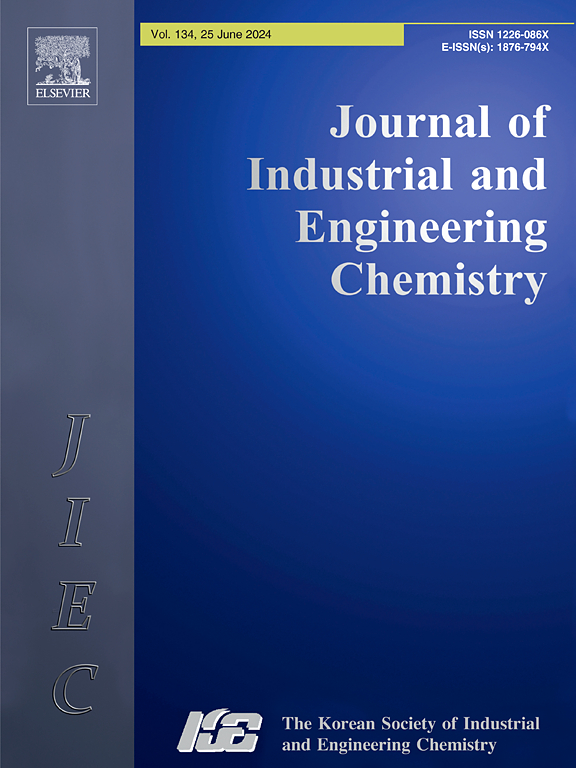The effect of chemically modified expandable graphite on flame-retardant properties of waterborne intumescent flame-retardant coating
IF 5.9
3区 工程技术
Q1 CHEMISTRY, MULTIDISCIPLINARY
Journal of Industrial and Engineering Chemistry
Pub Date : 2025-01-30
DOI:10.1016/j.jiec.2025.01.050
引用次数: 0
Abstract
In this study, a modified expandable graphite material (mEG) with enhanced hydrophilic properties was successfully prepared with a natural graphite as the main raw material and polymeric 4,4′‐methylene diphenyl isocyanate (pMDI) as an interlinking agent, and polyethylene glycol (PEG) as surface modifier. X-ray diffraction (XRD) and volume expansion analyses verified the anion intercalation that produced the expandable graphite (EG). And the results of X-ray photoelectron spectroscopy (XPS) and thermogravimetric analysis (TGA) raveled that 6.9% of PEG was chemically anchored on the expandable graphite (EG) surface. The contact angle of mEG was 39.6°, indicating that the surface is more hydrophilic than that of the EG surface (79.7°). The intumescent flame-retardant (IFR) coatings exhibited a more satisfactory flame-retardant effect when a mEG was added into the acryl resin matrix because of the synergistic effect of the dispersibility of mEG in the acryl resin matrix, resulted in the limited oxygen index (LOI) from 23 to 26%. Moreover, the total heat release (THR) of the IFR coating with mEG significantly decreased compared with that of the pure coating. The enhanced flame retardancy was due to the well-dispersed mEG in the acryl resin matrix, which may cause continuous carbon layer in the later stages of combustion.

化学改性膨胀石墨对水性膨胀型阻燃涂料阻燃性能的影响
本研究以天然石墨为主要原料,以聚合物4,4′-亚甲基二苯基异氰酸酯(pMDI)为交联剂,聚乙二醇(PEG)为表面改性剂,成功制备了具有增强亲水性的改性可膨胀石墨材料(mEG)。x射线衍射(XRD)和体积膨胀分析证实了阴离子插入产生了可膨胀石墨(EG)。x射线光电子能谱(XPS)和热重分析(TGA)结果表明,6.9%的聚乙二醇被化学锚定在可膨胀石墨(EG)表面。mEG的接触角为39.6°,表明其表面亲水性优于EG表面(79.7°)。在丙烯酸树脂基体中加入mEG,由于mEG在丙烯酸树脂基体中分散性的协同作用,使膨胀型阻燃涂料的限氧指数(LOI)由23提高到26%,阻燃效果较好。此外,与纯涂层相比,含有mEG的IFR涂层的总放热量(THR)显著降低。阻燃性能的增强是由于mEG在丙烯酸树脂基体中分散良好,在燃烧后期可能形成连续的碳层。
本文章由计算机程序翻译,如有差异,请以英文原文为准。
求助全文
约1分钟内获得全文
求助全文
来源期刊
CiteScore
10.40
自引率
6.60%
发文量
639
审稿时长
29 days
期刊介绍:
Journal of Industrial and Engineering Chemistry is published monthly in English by the Korean Society of Industrial and Engineering Chemistry. JIEC brings together multidisciplinary interests in one journal and is to disseminate information on all aspects of research and development in industrial and engineering chemistry. Contributions in the form of research articles, short communications, notes and reviews are considered for publication. The editors welcome original contributions that have not been and are not to be published elsewhere. Instruction to authors and a manuscript submissions form are printed at the end of each issue. Bulk reprints of individual articles can be ordered. This publication is partially supported by Korea Research Foundation and the Korean Federation of Science and Technology Societies.

 求助内容:
求助内容: 应助结果提醒方式:
应助结果提醒方式:


